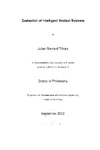Evaluation of lntelligent Medical Systems
| dc.contributor.author | Tilbury, Julian Bernard | |
| dc.contributor.other | Faculty of Science and Engineering | en_US |
| dc.date.accessioned | 2013-10-31T10:00:28Z | |
| dc.date.available | 2013-10-31T10:00:28Z | |
| dc.date.issued | 2002 | |
| dc.identifier | NOT AVAILABLE | en_US |
| dc.identifier.uri | http://hdl.handle.net/10026.1/2486 | |
| dc.description.abstract |
This thesis presents novel, robust, analytic and algorithmic methods for calculating Bayesian posterior intervals of receiver operating characteristic (ROC) curves and confusion matrices used for the evaluation of intelligent medical systems tested with small amounts of data. Intelligent medical systems are potentially important in encapsulating rare and valuable medical expertise and making it more widely available. The evaluation of intelligent medical systems must make sure that such systems are safe and cost effective. To ensure systems are safe and perform at expert level they must be tested against human experts. Human experts are rare and busy which often severely restricts the number of test cases that may be used for comparison. The performance of expert human or machine can be represented objectively by ROC curves or confusion matrices. ROC curves and confusion matrices are complex representations and it is sometimes convenient to summarise them as a single value. In the case of ROC curves, this is given as the Area Under the Curve (AUC), and for confusion matrices by kappa, or weighted kappa statistics. While there is extensive literature on the statistics of ROC curves and confusion matrices they are not applicable to the measurement of intelligent systems when tested with small data samples, particularly when the AUC or kappa statistic is high. A fundamental Bayesian study has been carried out, and new methods devised, to provide better statistical measures for ROC curves and confusion matrices at low sample sizes. They enable exact Bayesian posterior intervals to be produced for: (1) the individual points on a ROC curve; (2) comparison between matching points on two uncorrelated curves; . (3) the AUC of a ROC curve, using both parametric and nonparametric assumptions; (4) the parameters of a parametric ROC curve; and (5) the weight of a weighted confusion matrix. These new methods have been implemented in software to provide a powerful and accurate tool for developers and evaluators of intelligent medical systems in particular, and to a much wider audience using ROC curves and confusion matrices in general. This should enhance the ability to prove intelligent medical systems safe and effective and should lead to their widespread deployment. The mathematical and computational methods developed in this thesis should also provide the basis for future research into determination of posterior intervals for other statistics at small sample sizes. | en_US |
| dc.language.iso | en | en_US |
| dc.publisher | University of Plymouth | en_US |
| dc.title | Evaluation of lntelligent Medical Systems | en_US |
| dc.type | Thesis | |
| plymouth.version | Full version | en_US |
| dc.identifier.doi | http://dx.doi.org/10.24382/4119 |
Files in this item
This item appears in the following Collection(s)
-
01 Research Theses Main Collection
Research Theses Main


